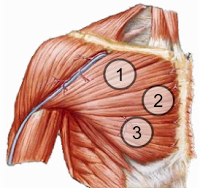
Deep breast pain and shooting pains in the breast are often difficult to understand and treat. Sometimes deep breast pain or shooting pains through the breast tissue may be due to yeast infection (sometimes called “ductal thrush”) or a bacterial infection (mastitis). Ductal spasms, called “refilling pain” are thought to be from the milk ducts first emptying, and then refilling with newly made milk, causing tiny muscle spasms. Vasospasm or vasoconstriction of the breast or the nipple, due to pain or damage like a cracked nipple, or hypersensitivity to temperature change or cold (called Raynaud’s Syndrome) can also cause severe nipple and deep breast pain.
Nipple pain, damage and compression can result in vasoconstriction of the tissue and produce radiating pain, often described as shooting pain or stabbing pain in the breast. Because the breast is painful, the nipple, or the latch, is not always pinpointed as the source.
Misdiagnosis is common: mothers and babies are treated, sometimes with minimal benefit, for thrush, infection, tongue or lip ties.
Things that may help deep breast aching or shooting pains in the breast:
Heat to the Breast. A hot shower, hot water bottle, rice sock or heating pad to the area.
Gently “Combing” the breast in the shower. Soap up your breast so it’s slippery, then use a wide-toothed comb to gently “comb” the breast from the ribcage, up toward the nipple, and continue all around the breast. Then shower, and repeat one more time before exiting.
Ibuprofen every six hours for 48 hours to break the cycle of inflammation
If ibuprofen (Advil, Motrin) is a medication you can safely take, the accepted dose for this purpose is 600 mg, taken with food, every six hours for a full 48 hours.
Stretching of the Pectoralis Major and Pectoralis Minor These muscles are located under and connected to your breast tissue, between your breast and the ribcage. Specific exercises are quick and easy to do morning and evening to promote blood flow, improve muscle strength and flexibility, and reduce pain from friction, adhesions or other irritation.
Here is an easy to follow, effective guide to simple pectoral stretches – give them a try for 30 seconds each stretch, each side, three times a day.